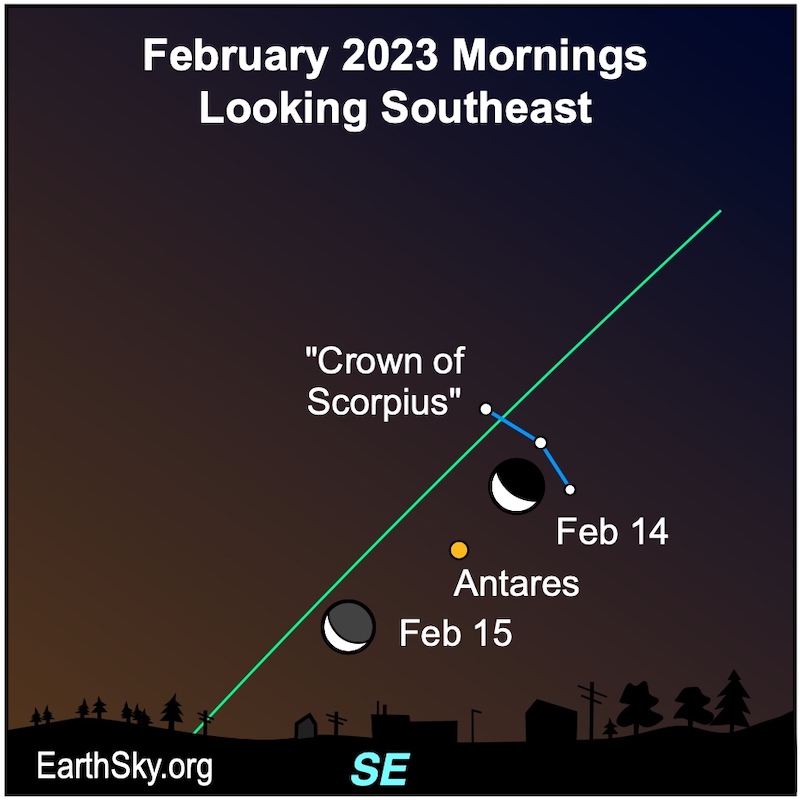
Moon near Antares
The waning crescent moon will rise in the wee morning hours alongside Antares on the mornings of February 14 and 15, 2023. Antares is the brightest star in Scorpius the Scorpion and has the nickname of The Heart of the Scorpion. You can also spy the Crown of Scorpius – a slightly curved line of three stars – near the moon on these mornings.
Since the view of the stars, moon and planets varies by your position on the globe, we suggest you try Stellarium for a precise star chart for your location.
Antares is close to death
Antares is a red supergiant star. So, this large, 1st-magnitude star is close to the end of its life. Someday soon (astronomically speaking), it will effectively run out of fuel and collapse. The resulting rapid collapse of its enormous mass – some 11-14 times the mass of our sun – will cause an immense supernova explosion, ultimately leaving a tiny neutron star or possibly a black hole. This explosion, which could be tomorrow or millions of years from now, will be a spectacular show from Earth, but we are far enough away that there likely is no danger to our planet.
Stars in the Crown of Scorpius
Can you also spot the Crown of the Scorpion, which marks the Scorpion’s Head? It’s a slightly curved arc of three stars: Acrab, Dschubba, and Fang.
Incidentally, the upper part of the Scorpion – Antares at the Heart, and the three stars of the Crown – are all part of a group of young stars known as the Scorpius–Centaurus Association. So these stars were likely born together from a single cloud of gas and dust in space. And they still move through space as a loosely associated group of stars.
Bottom line: Find the waning crescent moon near Antares on the mornings of February 14 and 15, 2023. You may also spot the Crown of Scorpius nearby.
For more great observing events in the coming weeks, visit EarthSky’s night sky guide
The post See the moon near Antares on February 14 and 15 first appeared on EarthSky.
from EarthSky https://ift.tt/bGafK3F

Moon near Antares
The waning crescent moon will rise in the wee morning hours alongside Antares on the mornings of February 14 and 15, 2023. Antares is the brightest star in Scorpius the Scorpion and has the nickname of The Heart of the Scorpion. You can also spy the Crown of Scorpius – a slightly curved line of three stars – near the moon on these mornings.
Since the view of the stars, moon and planets varies by your position on the globe, we suggest you try Stellarium for a precise star chart for your location.
Antares is close to death
Antares is a red supergiant star. So, this large, 1st-magnitude star is close to the end of its life. Someday soon (astronomically speaking), it will effectively run out of fuel and collapse. The resulting rapid collapse of its enormous mass – some 11-14 times the mass of our sun – will cause an immense supernova explosion, ultimately leaving a tiny neutron star or possibly a black hole. This explosion, which could be tomorrow or millions of years from now, will be a spectacular show from Earth, but we are far enough away that there likely is no danger to our planet.
Stars in the Crown of Scorpius
Can you also spot the Crown of the Scorpion, which marks the Scorpion’s Head? It’s a slightly curved arc of three stars: Acrab, Dschubba, and Fang.
Incidentally, the upper part of the Scorpion – Antares at the Heart, and the three stars of the Crown – are all part of a group of young stars known as the Scorpius–Centaurus Association. So these stars were likely born together from a single cloud of gas and dust in space. And they still move through space as a loosely associated group of stars.
Bottom line: Find the waning crescent moon near Antares on the mornings of February 14 and 15, 2023. You may also spot the Crown of Scorpius nearby.
For more great observing events in the coming weeks, visit EarthSky’s night sky guide
The post See the moon near Antares on February 14 and 15 first appeared on EarthSky.
from EarthSky https://ift.tt/bGafK3F

Aucun commentaire:
Enregistrer un commentaire